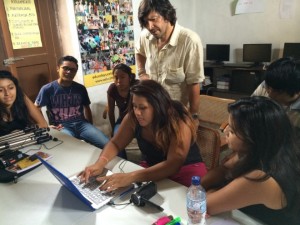We are Julie Poncelet, Catherine Borgman-Arboleda, and Jorge Arboleda of Action Evaluation Collaborative, independent consultants who use evaluation to strengthen social change. We want to share our experiences using participatory video (PV) in evaluations with youth.
PV is a dynamic, powerful approach whereby youth use video to capture everything from their stories of change to issues that affect their everyday lives to ideas they have to effectuate change in their communities. As pictured below, we recently engaged PV with a group of teens from a community-based NGO in Yucatan, Mexico. Youth produced videos about their dreams and senses of identity. PV is a compelling approach to explore these themes, which emerged from a Theory of Action process with the NGO; specifically identified was the need to have youth analyze critically their communities and find their voices.
PV positions youth as researchers and evaluators of their own communities and supports them to contribute creatively and critically to issues. With PV, youth design, direct, film, and edit videos. They experience empowerment, ownership, and self-esteem rarely garnered from other evaluation approaches. Adults provide technical assistance, build capacity, and facilitate a process for PV to unfold (not to take over the process!). For evaluations, PV creates a space for community members and stakeholders to see the interests and needs of youth in the community and provides a unique platform to reflect collaboratively on meaning and implications.
Lessons Learned: Focus should be on learning the technology and the video storytelling process, as well as providing an appropriate approach for young people to collectively reflect on themselves and their realities. Give youth time to feel comfortable with the equipment and with engaging others in conversation. And remain aware of group dynamics! We often find that boys are more comfortable and will take leadership with technology, so consider breaking groups up by gender.
Consider using a short set of questions that can be asked by youth to stakeholders included in their videos. The insight can help to contextualize the analysis and overall sense-making. The PV process is as much an outcome as the product; engaging in PV is transformative, so don’t worry about getting ‘perfect’ videos.
Hot Tips: Although building a participatory video kit is not cheap, all you really need is a small camera (preferably with projecting capabilities) and a good quality hand held microphone. We have found that when young people hold the microphone, they feel more empowered to speak, so it helps them to find their voice.
Rad Resources: The PV approach aligns nicely with other qualitative methods (Most Significant Change) and different types of evaluations (Monitoring & Evaluation).
The American Evaluation Association is celebrating Youth Focused Evaluation (YFE) TIG Week with our colleagues in the YFE AEA Topical Interest Group. The contributions all this week to aea365 come from our YFE TIG members. Do you have questions, concerns, kudos, or content to extend this aea365 contribution? Please add them in the comments section for this post on the aea365 webpage so that we may enrich our community of practice. Would you like to submit an aea365 Tip? Please send a note of interest to aea365@eval.org. aea365 is sponsored by the American Evaluation Association and provides a Tip-a-Day by and for evaluators.



Julie, Catherine and Jorge I am the new executive director of the Fundación Punta de Mita in Nayarit, Mexico and I would love to connect with you to talk more about your work in the Yucatan and how you use participatory evaluation with youth there!
One of my primary goals at our community foundation will be fostering a culture of reflective practice through evaluation, both in our own organization as well as offering capacity training to nonprofits and other grassroots groups in the Bay of Banderas area.
There is a fantastic training program in Tepotzlán, between Mexico City and Cuernavaca on participatory evaluation for any of those interested. The website is http://www.mosaic-net-intl.ca/stakeholder.shtml
Pingback: YFE TIG Week: Julie Poncelet on Participatory Methods to Engage Youth in Evaluation · AEA365
G’day Team Action Evaluation Collaborative!
Yes! Student Centered Learning with Empowerment a key aspect: Score! 😉
While I was attending Rockford University in Rockford Illinois as a full-time Graduate student, I was concurrently serving as a Long Term Guest Teacher (formerly referred to as a Substitute Teacher) in Rockford Public Schools District 205 (RPS #205) at one of their many Title I high schools, wide a large Hispanic/Latino student populations, followed by a significant number of African-American students. The solo theatre arts teacher was taking time for a maternity leave experience. She handed over the department keys and with them: her/our students. As the Main Stage show was “in the history books”, I took charge and configured all Ensembles (classes) in Color groups (cooperative learning teams) of 3 and 4 members–undergo a similar project.
However, in lieu of expense equipment and exhaustive programs; each group would work together to pool resources. This meant a collaborative effort to use on-hand tools (i.e. personal cell phones, iPads, et al) and creativity to present a message of self and community importance. Following the basic production cycle (Pre-, Pro-, Post-production) and story boarding with a basic minimum outline following the “beginning-middle-end” template; ALL student populations were able to participate. More savvy students used advanced models which included exposition, rising action, conflict, climax, resolution and epilogue.
Results did yield a number of exciting student written, directed, produced, and performed videos on a variety of subjects in a number of genres.
These projects were enjoyed across the student demographic spectrum with the ladies taking very active roles behind and in-front of the camera.
I did video each group’s in-class presentation and collected links of all completed video scenes to share with Mrs. Sarah upon her return.
Skills were transferable. Fun was experienced by all participants and spectators on man levels.
Thank you for posting this article and sharing your experiences.
All the Best,
Capt. Richard Arlington Briggs, Jr.
TAMUCT Graduate Assistant, Research Center, College of Education.